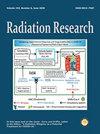利用循环游离细胞 DNA (cfDNA) 进行辐射/核快速分诊的辐射生物毒性测量法。
IF 2.5
3区 医学
Q2 BIOLOGY
引用次数: 0
摘要
最佳的分流生物测量法将包括在几分钟内进行风险分层,并在不同剂量、细胞因子疗法、混合辐射质量、种族和年龄的情况下提供有用的分流。美国食品和药物管理局(FDA)的《生物测定指南》规定,要获得监管部门的批准,生物测定必须符合目的要求,并具有经过验证的独立于物种的机制。循环游离细胞 DNA(cfDNA)浓度测定可提供此类分流信息。为了验证这一假设,我们利用实验室开发的检测方法,采用支链 DNA(bDNA)技术测量了未经处理的猴血浆中的 cfDNA 浓度。因此,放射肿瘤诊所越来越多地使用 cfDNA 浓度测量来预测副作用风险。在接受 1 至 6.5 Gy 全身辐射剂量的猕猴中,cfDNA 水平以及造血参数在 7 天内得到了测量。低剂量辐照(0-2 Gy)与高剂量全身辐照(5.5 和 6.5 Gy)很容易区分。在猴子模型中,cfDNA的折叠变化与接受超致死辐射剂量的骨髓移植患者的测量结果相当,这表明不同物种的cfDNA浓度的致死阈值可能相似。辐照前的 cfDNA 平均水平为 50 ± 40 纳克/毫升[±1 标准差 (SD)],1 Gy 时为 120 ± 13 纳克/毫升;2 Gy 时为 242 ± 71 纳克/毫升;5.5 Gy 时为 607 ± 54 纳克/毫升;6.5 Gy 时为 1585 ± 351 纳克/毫升(±1 标准差)。cfDNA 浓度随辐射剂量呈指数增长。将猴子模型与小鼠模型和利用切尔诺贝利事故反应者数据开发的 Guskova 模型进行比较,进一步证明了不同物种之间的相关性,支持相似的作用机制。在美国和欧盟,该测试以临床实验室改进修正案(CLIA)的形式在市场上销售。剩下的挑战包括开发进一步简化标本处理和化验评估的方法,以及更准确地校准分流类别与 cfDNA 浓度临界值。本文章由计算机程序翻译,如有差异,请以英文原文为准。
Radiation Biological Toximetry Using Circulating Cell-Free DNA (cfDNA) for Rapid Radiation/Nuclear Triage.
Optimal triage biodosimetry would include risk stratification within minutes, and it would provide useful triage despite heterogeneous dosimetry, cytokine therapy, mixed radiation quality, race, and age. For regulatory approval, the U.S. Food and Drug Administration (FDA) Biodosimetry Guidance requires suitability for purpose and a validated species-independent mechanism. Circulating cell-free DNA (cfDNA) concentration assays may provide such triage information. To test this hypothesis, cfDNA concentrations were measured in unprocessed monkey plasma using a branched DNA (bDNA) technique with a laboratory developed test. Therefore, cfDNA concentration measurements are increasingly used in radiation oncology clinics to predict side effect risk. The cfDNA levels, along with hematopoietic parameters, were measured over a 7-day period in Rhesus macaques receiving total body radiation doses ranging from 1 to 6.5 Gy. Low-dose irradiation (0-2 Gy) was easily distinguished from high-dose whole-body exposures (5.5 and 6.5 Gy). Fold changes in cfDNA in the monkey model were comparable to those measured in a bone marrow transplant patient receiving a supralethal radiation dose, suggesting that the lethal threshold of cfDNA concentrations may be similar across species. Average cfDNA levels were 50 ± 40 ng/mL [±1 standard deviation (SD)] pre-irradiation, 120 ± 13 ng/mL at 1 Gy; 242 ± 71 ng/mL at 2 Gy; 607 ± 54 at 5.5 Gy; and 1585 ± 351 at 6.5 Gy (±1 SD). There was an exponential increase in cfDNA concentration with radiation dose. Comparison of the monkey model with the mouse model and the Guskova model, developed using Chernobyl responder data, further demonstrated correlation across species, supporting a similar mechanism of action. The test is available commercially in a Clinical Laboratory Improvement Amendments (CLIA) ready form in the U.S. and the European Union. The remaining challenges include developing methods for further simplification of specimen processing and assay evaluation, as well as more accurate calibration of the triage category with cfDNA concentration cutoffs.
求助全文
通过发布文献求助,成功后即可免费获取论文全文。
去求助
来源期刊

Radiation research
医学-核医学
CiteScore
5.10
自引率
8.80%
发文量
179
审稿时长
1 months
期刊介绍:
Radiation Research publishes original articles dealing with radiation effects and related subjects in the areas of physics, chemistry, biology
and medicine, including epidemiology and translational research. The term radiation is used in its broadest sense and includes specifically
ionizing radiation and ultraviolet, visible and infrared light as well as microwaves, ultrasound and heat. Effects may be physical, chemical or
biological. Related subjects include (but are not limited to) dosimetry methods and instrumentation, isotope techniques and studies with
chemical agents contributing to the understanding of radiation effects.
 求助内容:
求助内容: 应助结果提醒方式:
应助结果提醒方式:


